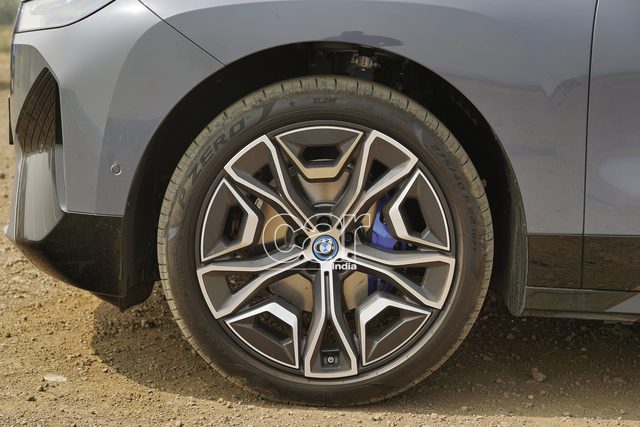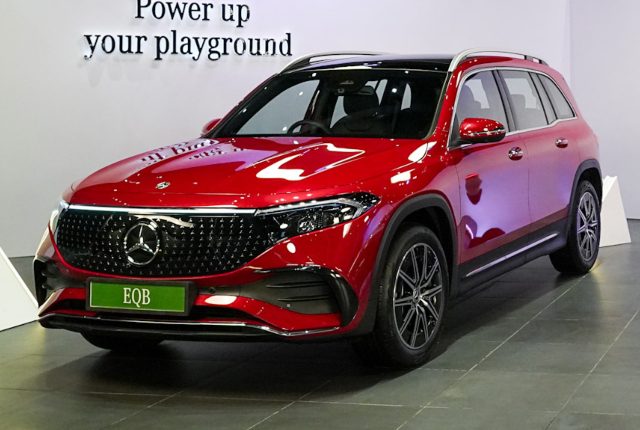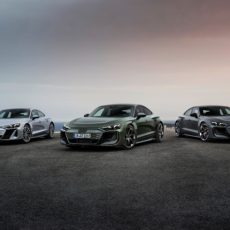The BMW iX range gets one more option in the form of the top-shelf xDrive50. We take it out for a spin to see if it is worth the extra money.

Story: Joshua Varghese
Photography: Sanjay Raikar
Like most luxury manufacturers, BMW are also offering luxury sport utility vehicles (SUV) that could easily pass for spaceships. The iX is their flagship electric SUV and it has been on sale in India for a while now. What is new about this one then? This is the top-shelf xDrive50 and we aim to help you decide if it is worth the premium over the xDrive40 that arrived earlier.
Visually, there is not much to tell the xDrive40 and xDrive50 apart. This one is also dimensionally comparable to the X5 with a roof-line like the X6’s and the car we drove had the optional 22-inch Air Performance wheels. These are not only optimized for aero but are also lighter than stock units. In this grey paint scheme, the iX has a commanding presence that is subtly but tastefully projected. As with all electric vehicles (EV), aerodynamics has played a significant role in the design of the iX. Each of its curves and creases has been sculpted to facilitate the passage of air, even manipulate it in some instances.

The most obvious elements of this approach include the flush-fitting door-handles and the slim, over-engineered mirrors. In fact, the effect is so pronounced that BMW claim aero alone contributes to 65 kilometres of the car’s range. One may argue that by submitting to the demands of aerodynamics, BMW may have compromised on the muscular character of their SUV family but their attention to detail remains intact. A good example would be the secondary tail-lights under the large seamless boot-lid. Useful to alert other road-users when the boot is open.

While the exterior of the iX may not be to everyone’s liking, its cabin is unlikely to elicit an unfavourable reaction. Since the iX was developed from scratch to be an EV, BMW have optimized space and convenience as never before without any compromise on the luxury that is expected from the segment. Seats in the front row have ample leg-room and head-room and the absence of a central console only adds to the cause. Furthermore, the seats are made of sustainably sourced material. In addition to keeping me firmly in place, they also did an excellent job of reminding me that I was in a luxury car.
BMW have gone out of their way to make the driver feel special, like the pilot of a spacecraft. The hexagonal steering wheel makes its first-ever appearance in a BMW and it is not bad at all. It feels great to hold, intuitive to use, and there is an unrestricted view of the driver’s console which may easily be described as futuristic. Other details include the curvature of the touchscreen infotainment system which is ever so slightly tilted towards the driver, a head-up display, and beautiful crystal pieces set into a wood veneer which act as the infotainment control and gear selector. A Harman Kardon sound system with 18 speakers handles all your audio needs and also the ambient music. Developed in collaboration with the world renowned composer, Hans Zimmer, the iX has its own background music that adds a sense of occasion to the drive. It did make me feel like I was starring in a Nolan flick.

Be it in the passenger seat or in the rear, the space and choice of materials are easy to appreciate and while life as a passenger is best spent in the front row, the rear is not too far behind. Although it is not as rich in features as the front, the rear is comfortable and makes the iX an excellent chauffeur-driven car. However, if I had a chauffeur, he would spend very little time driving because this flagship Bimmer is a compelling package that is best experienced hands-on.

A massive 105.2-kWh battery pack supplies current to two electric motors; one at each axle. The combined output of 523 hp and 765 Nm shoot the iX from 0 to 100 km/h in less than five seconds. Having a clever all-wheel-drive system ensures that traction is easy to find and the car slices through the air like an arrow from a bow. Top speed has been restricted to 200 km/h, more than enough for our country. What is more relevant for us is the range and this one promises to return 630 kilometres per charge. Although we could not do a proper range test on this occasion, I am confident enough to drive to Goa—maybe, even further—without having to stop for a top-up. Speaking of which, 0-100 per cent charge can be achieved off an 11-kW AC charger in less than 11 hours and, for emergencies, it is reassuring to know that it can go from 10 to 80 per cent in 35 minutes when plugged into a 200-kW DC charger.

A thick veil of electronics act as an interface between all forms of driver input and their outcomes. While it does rob the car of some of the pure driving pleasure that I would associate with a BMW, it does make life a lot easier. Calibration in each mode is appropriate and the car never really lets one do anything silly. In fact, there are so many active and passive systems working all the time that the iX has the largest number of driver assistance systems ever fitted as standard in a BMW.
The BMW iX is my benchmark for handling among EVs in that price bracket but what have they done differently vis-a-vis their peers? They have taken some points out of the handbook they used to build the latest 7 Series. While that land yacht benefits from the “Carbon Core” construction, the iX makes use of something BMW like to call “Carbon Cage”. The material used in this construction includes carbon fibre-reinforced plastic, thermoplastic, steel, and aluminium. The lighter and stiffer material is used in the top half of the car which allows the shell to retain its integrity while keeping the centre of gravity close to the bottom.
On the road, that translates into a drive that transforms this electric flagship into a much smaller machine. Its 2.5-tonne heft was noticeable but it still turned into corners well and, at least on public roads, it was very evident that I was nowhere near the limit of its capabilities. The car we drove was equipped with air suspension and it is certainly worth the extra cost. It is capable of working each wheel independently and the damping is adjusted many times per second. Even if the iX is loaded unevenly, the suspension balances itself out. Furthermore, the ride height can be adjusted to make the most of anything our roads may throw at you. The iX gets an electric steering system that has speed-sensitive power assistance which makes the car exceptionally stable on the highway and instils confidence when cornering hard while also making parking in tight spaces convenient. Sounds like an ideal package but it is not. However, it could be if one chooses to also buy rear-wheel steering. That would have made my life a lot easier when turning the car around in tight spaces.

Braking in the iX is rapid and composed but the feel at the pedal is something one needs to get used to. Simply put, it is electrically actuated which allows the car to accurately provide the required brake pressure. While the feeling at the pedal is consistent and the stopping distances are remarkable, the pulse of the ABS, for example, is not felt at all. Unless one needs to brake hard all the time, the regenerative braking is more than enough to slow the car down. Plus, there is the one-pedal driving mode, if needed.
The price of the BMW iX xDrive50 has not been announced yet but we expect it to be at least Rs 30 lakh more expensive than the xDrive 40, which is priced at Rs 1.21 crore (ex-showroom). As a luxury SUV, the iX xDrive40 had impressed us but if one intends to drive most of the time, rather than being driven in, then the xDrive50 is the more appropriate choice. Otherwise, there is no reason to give up on saving that extra money.

The xDrive50’s main rivals include the Audi Q8 e-tron Sportback (Rs 1.30 crore, ex-showroom) and the Mercedes EQE SUV 500 4MATIC (Rs 1.39 crore, ex-showroom). By the way, there is one more rocket in the iX range. It is called the M60 and, on paper at least, it is extremely difficult to ignore. You could wait for its India début but a launch date is yet to be announced.
Edited on 21 March 2024: The BMW iX xDrive50 has been launched with prices starting from Rs 1.40 crore (ex-showroom). Interestingly, with the launch of the xDrive50, BMW have removed the xDrive40 from their website. Did not see that coming. Well played, BMW.
Watch the full video here:
Also Read: BMW XM Test Review











